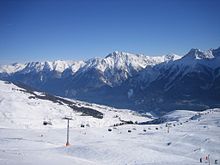Graubünden ist ein Kanton in der Schweiz und liegt vollständig in den Alpen.
Graubünden ist der einzige Kanton mit drei Amtssprachen: Deutsch, Rätoromanisch und Italienisch. Er ist zudem der einzige Kanton mit Rätoromanisch und neben dem Tessin der einzige Kanton mit Italienisch als Amtssprache.
Der Größte Ort ist Chur.
Graubünden ging 1803 aus dem 1471 gebildeten Freistaat der Drei Bünde hervor. Der bedeutendste Bund der Drei Bünde war der Graue Bund - nach diesem wurde das Kanton dann benannt.
Der Graue Bund wurde 1367 gegründet und 1442 erstmals erwähnt.
Der Name Graubünden wurde 1803 mit der von Napoleon Bonaparte erlassenen Mediationsakte offiziell.
Das Wappen setzt sich aus den Wappen der Drei Bünde zusammen.
Die Gemeinden und Kreise sind autonom, ihre eigene Amts- und Schulsprachen festzulegen, der Kanton setzt allerdings Richtlinien. Gemäß Artikel 16 des Bünder Sprachgesetzes von 2006 gelten Gemeinden, in denen mindestens 40% der Einwohner das angestammte Idiom sprechen, als einsprachig und Gemeinden, in denen wenigstens 20% das angestammte Idiom sprechen, als zweisprachig.
Die für die dauerhafte Besiedlung mancher Talschaften unabdingbare Berglandwirtschaft überlebt dank Nischenproduktion (Nutzhanf), sowie Subventionen. Allerdings arbeiten nur 8% der Bevölkerung in der Land- und Forstwirtschaft.
24% arbeiten hingegen in Industrie und Gewerbe. Der wichtigste Wirtschaftszweig ist der Dienstleistung Sektor, vor allem der Tourismus.
Der Fremdenverkehr, ursprünglich eine Sommeraktivität, wurde schon 1865 durch die Bündner Erfindung des Wintertourismus ergänzt, die Brennpunkte sind die Regionen Oberengadin, Davos/Klosters, Arosa, Lenzerheide und Flims.
Graubünden ist der Kanton mit der grössten Dichte an Burgen und weist mit dem Benediktinerinnenkloster St. Johann in Müstair, dem Dorf Soglio und der Kirche von Zillis Kulturgüter von Weltrang auf.Neu dazugestossen ist die Anlage der Rhätischen Bahn im Albulatal. Auch die Bahnstrecke über den Bernipass ist von großer architektonischer Bedeutung, während die Tektonik Arena Sardona
als Weltkulturerbe gelistet wird. Seit 1991 ist die Salginatorbrücke der Verbindungsstrasse von Schiers nach Schuders das bislang einzige Weltmonument der Schweiz.___________________________________________________________________________________
Graubünden is a canton in Switzerland and lies entirely in the Alps. Graubünden is the only canton with three official languages: German, Romansh and Italian. It is also the only canton with Romansh and, along with Ticino, the only canton with Italian as an official language.
The largest place is Chur.
Graubünden emerged in 1803 from the Free State of the Three Leagues formed in 1471. The most important federation of the three federations was the gray federation - after this the canton was named. The Gray League was founded in 1367 and first mentioned in 1442.
The name Graubünden became official in 1803 with the Mediation Act issued by Napoleon Bonaparte.
The coat of arms consists of the coats of arms of the three federations.
The communities and districts are autonomous in determining their own official and school languages, although the canton sets guidelines. According to Article 16 of the 2006 Bünder Language Act, municipalities in which at least 40% of the inhabitants speak the ancestral idiom are considered monolingual and municipalities in which at least 20% speak the ancestral idiom are considered bilingual.
Mountain agriculture, which is essential for the permanent settlement of some valleys, survives thanks to niche production (hemp) and subsidies. However, only 8% of the population works in agriculture and forestry. 24% work in industry and commerce. The main industry is the service sector, especially tourism.
Tourism, originally a summer activity, was supplemented as early as 1865 by the Graubünden invention of winter tourism. The focal points are the Upper Engadine, Davos/Klosters, Arosa, Lenzerheide and Flims regions.
Graubünden is the canton with the highest density of castles and has world-class cultural assets with the Benedictine monastery of St. Johann in Müstair, the village of Soglio and the church of Zillis.
The Rhaetian Railway system in the Albula Valley has recently been added. The railway line over the Berni Pass is also of great architectural importance, while the tectonic Arena Sardona listed as a World Heritage Site. Since 1991, the Salginator Bridge on the connecting road from Schiers to Schuders has been the only world monument in Switzerland to date.






Kommentare
Kommentar veröffentlichen